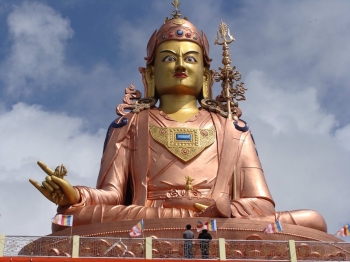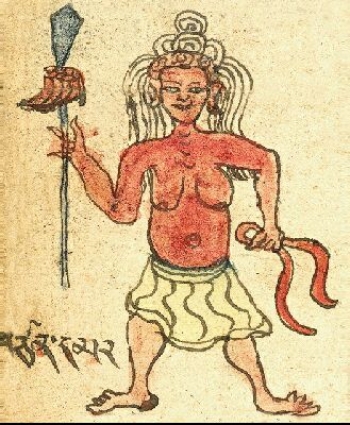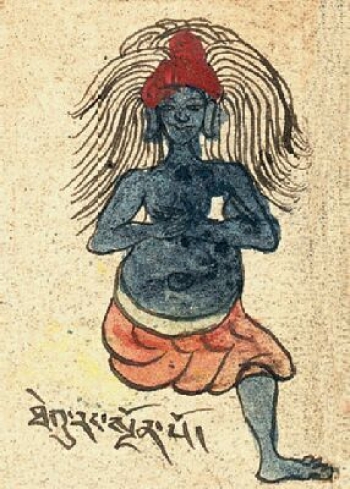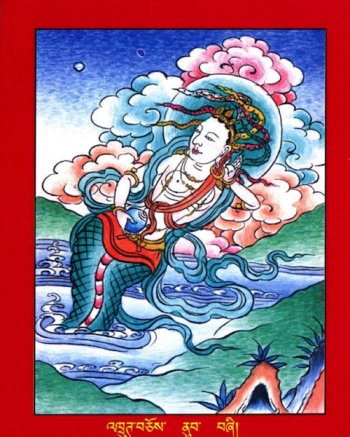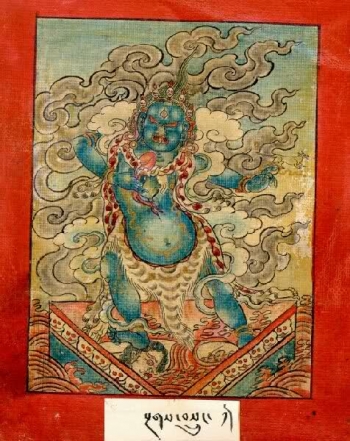Whether by the titanic mountains of the Himalayan range or the weird, lonely, lunar expanse of the plateau itself, it is not unusual to feel overwhelmed by the natural landscape of Tibet. It is small wonder, then, that from the earliest times, the Tibetans populated this imposing topography with a multitude of spirits, demons, and gods.
Foremost amongst them are the many gods and goddesses who are supposed to reside on one or another of the many mountain peaks in Tibet—it can be said that there is scarcely a peak in Tibet that is not regarded as the abode of some god or goddess. These deities are often considered by tradition to be the ancestors of the local population, and the founders of many Tibetan states and clans are generally thought to be the sons or daughters of mountain gods. A famous example of this is the legendary King Gesar of Ling—the revered and fearless hero of one of the longest epic cycles in the world—whose mother dreams of a yellow man who makes love to her, from which tryst she later gives birth to Gesar. The yellow man is in fact the mountain god Anye Machen, who resides on a mountain of the same name in the Kunlun range in present-day Qinghai Province in China. The mountain gods are at the center of a rich and varied ritual tradition. Rituals and festivals are held to propitiate them in order to secure the health and fertility of the local people and livestock; for protection from epidemics and disasters; and for timely rain and bountiful harvests. Some of the more powerful gods are venerated far from their rocky abodes, and their likeness found in the iconography of Tibetan Buddhism.
While mountain gods and goddesses are the best known, they are only one particular class in the pantheon of gods, demons, and spirits which inhabit the natural world. Such spirits are not restricted to the towering peaks, but are also said to haunt the domed hills, icy glaciers, rivers, lakes, and subterranean springs. From the luxuriant forests in eastern Tibet to the desolate plains to the north, there is scarcely a topographical feature of any significance which is not said to be the haunt of some spirit or other.
Among the best-known spirits are the nyen—a race of malevolent beings who are believed to roam the mountains and hills. They are usually found residing in strange or anomalous natural formations such as ditches and rocks. Others haunt the dark depths of the forest or lurk near lakes and rivers. When their territory is disturbed by humans, to whom the nyen are intrinsically hostile, they are said to curse the trespassers with both physical afflictions (such as lameness and the plague) and social ills (like gossip).The rocks and crags of Tibet’s mountains and hills are home to the tsen, powerful red-colored vampiric spirits who are usually depicted in iconography as mounted knights dressed in finely wrought armor. It is customary to dismount from one’s horse in areas haunted by the tsen, since they are easily offended by those they perceive to be riding haughtily through their domain. Up high in the ether dwell the theu-rang, a race of malign imps that delight in mischief and chaos. They are said to inflict illness upon children and are responsible for hiding or moving household objects, much to the annoyance of the householders.
Beneath the surface of the earth and deep within rivers, lakes, and springs live the lu —serpentine water spirits which have been identified with the nagas of India. The lu can at times be benevolent, rewarding the favored with trinkets from their subterranean treasure hoards; however, if their abode is polluted, or should they be slighted in some other way, they are thought to bring leprosy and other diseases upon humans and their livestock. The lu share the subterranean realms with the sadag—spirits who dwell in the depths of the earth and who, according to the Tibetan geomantic tradition, move around according to the cycle of the years, months, days, or hours. The exact position of the sadag needs to be determined before beginning the construction of new buildings as they are known to become enraged if their geomantic space is infringed upon. There are also mamo (demonesses), dre (demons), drib-dag (lords of pollution), and shing-dag, nas-dag, doen, and gegs, to name but a few more.
Many attempts have been made to classify this bewildering profusion of spirits. One of the most common is that of the lha srin de gyad (“eight classes of gods and demons”), the origins of which can be traced back to the Yarlung period (c. 7th–9th century), where the classification of lha lu de gyad (“eights classes of gods and nagas”) is found in manuscripts discovered in the library cave at Dunhuang, in China’s Gansu Province, in the early 20th century. The list of the eight classes has varied over the centuries, and the existence of several lists shows the localized nature of many of the legends and ritual traditions associated with these spirits.
